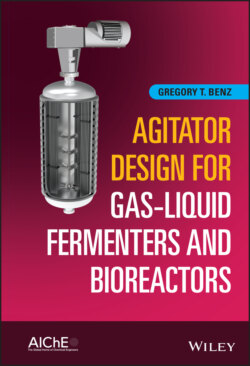Читать книгу Agitator Design for Gas-Liquid Fermenters and Bioreactors - Gregory T. Benz - Страница 79
Variable Gas Flow Operation
ОглавлениеThough some fermenters operate in a continuous mode, most operate in batch or semi‐batch mode, so that it is possible to create lot numbers (in the case of pharmaceutical products) or periodically sterilize and clean to approach aseptic operation. Batch and semi‐batch fermenters typically start out with a limited cell concentration and therefore a relatively low OUR. Although it is usually possible to run constant airflow, this is a wasteful practice, as less air is needed when the biomass concentration is low. Therefore, most fermenters operate with a variable airflow, starting low and increasing as needed, sometimes reducing near the end of the batch.
Airflow affects agitator power draw, as stated earlier. For some impellers, the gassing factor can be as low as 0.3 under peak airflow conditions. For others, it can be much higher. Some are as high as the density reduction factor, which is typically between 0.85 and 1.0. So, what airflow should the impeller system be designed for?
If the impeller system is designed to run ungassed at full shaft speed, it will draw less power at peak airflow conditions, where the most power is needed. Impellers that maintain a high gassing factor are preferred for this reason.
If the impeller system is designed to invest as much motor power as possible at maximum airflow and shaft speed, this is the best design for mass transfer. However, if the gas flow is reduced or eliminated, the impeller system will overload the motor, perhaps severely, unless the shaft speed is reduced. So, again, impellers with a high gassing factor are preferred, as it may even be possible to only slightly oversize the motor to allow ungassed operation.
Most fermenters have some sort of variable speed drive, the most common being variable frequency drives (VFDs). With such drives, it would be possible to design for maximum power at peak airflow and reduce speed as needed to operate at reduced or zero airflow. However, impellers with low gassing factors would have to be reduced further in speed than those with a high gassing factor, particularly considering the fact that VFDs and similar drives operate on a constant torque curve over about a 3 or 4 to 1 speed range, but not at constant power capability. That means the available power is equal to the rated motor power times the ratio of operating speed (or frequency) to full speed at the nominal power supply frequency.
The above points are illustrated in Figure 4.4.
Figure 4.4 shows a typical motor curve when operated on a VFD control. It is constant torque (% Hp = % speed) for a 4:1 ratio and variable torque (% Hp proportional to speed squared) below that. Superimposed on that curve are two operating points. Being compared are a high gassing factor impeller and a low gassing factor impeller. The high gassing factor impeller has a gassing factor of 0.85 at 1 VVM airflow and can run at 90% of full speed ungassed. The low gassing factor impeller has a gassing factor of 0.31 at 1 VVM and must have its speed reduced to 55% of full speed in order to avoid overloading the motor ungassed. This means it is impossible for the low gassing factor impeller to invest as much power at reduced airflow as would be possible with the high gassing factor impeller.
Figure 4.4 Available motor power curve using VFD.
